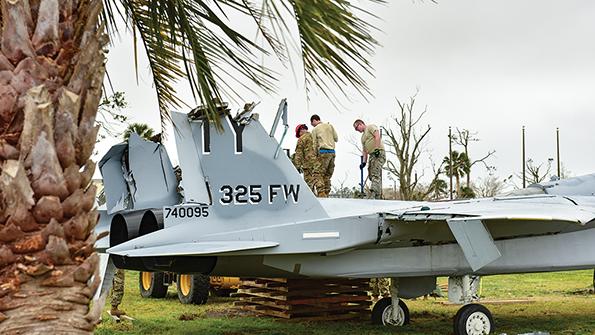
The U.S. Congress is providing the military with direct responses to the threat of climate change. The passage of defense policy legislation provides the military with new tools to address the effects of the warming globe on strategic security interests, installations and readiness.
- Congress addresses climate change in defense legislation
- Climate change negatively affects military training
That climate change is a threat to national security has been acknowledged by the military for nearly 30 years. In 1990, the U.S. Naval War College issued a report on “Global Climate Change Implications for the United States.” But in recent years, the issue has become politically charged, with the Republican-controlled House of Representatives voting in 2016 on an amendment to block Pentagon action on climate change.
Now legislative support for addressing the security effects of a warming planet is growing. The 2018 National Defense Authorization Act (NDAA) characterized climate change as a direct threat to national security. Two years later, lawmakers are uniting around potential solutions. Last month, President Donald Trump signed into law the 2020 NDAA, which includes 10 provisions related to climate security.
The bill made it through the Democrat-controlled House and the Senate, past Armed Services Committee Chairman Jim Inhofe (R-Okla.), who wrote a book in 2012 calling global warming The Greatest Hoax.
The 2020 NDAA mandates creation of a Climate Security Advisory Council within the intelligence community to ensure analysis is informed by the best possible science. Intelligence experts must incorporate the foresight scientists have in projecting stress on various regions to predict potential crises. Establishing a Climate and Security Council is a positive step, John Conger, director of the Center for Climate and Security, tells Aviation Week.
“If you know there is going to be a water shortage in some portion of the world, that would inform, for example, the assessment of whether that region is going to go unstable,” Conger says.

Another provision in the bill related to climate-security strategic interests for the U.S. revolves around the Arctic.
Section 1752 of the 2020 NDAA directs the Pentagon to consider sites for a strategic port in the Arctic and submit a report to Congress no later than June 2020. The document should include a cost estimate for construction and sustained operations at the site. For years, experts have rallied for the U.S. to have a more permanent presence in the Arctic as melting ice caps begin to open sea lanes to vessels from Russia and other nations.
As the Arctic continues to warm, extreme weather has hit hard at existing bases in the continental U.S. In 2018, Hurricane Michael decimated Tyndall AFB in Florida. Tyndall was home to the Air Force’s fleet of Lockheed Martin F-22 Raptors.
The Air Force is still coping with the aftermath. While Tyndall is undergoing repairs, F-22s assigned to the 43rd and 95th Fighter Sqdns. have moved to other installations. The jets assigned to the 43rd relocated to Eglin AFB in Florida, while the 95th’s aircraft are being spread out across F-22 units at Joint Base Elmendorf-Richardson in Alaska, Joint Base Pearl Harbor-Hickam in Hawaii, and Joint Base Langley-Eustis in Virginia.

The military is not just concerned about its coastal bases. A few months after Hurricane Michael floodwaters reached 7ft. (2.1 m), damaging Offutt AFB in Nebraska and causing personnel to move aircraft and munitions to higher ground. The flooding damaged one-third of the Midwestern base, home to the headquarters of the nation’s nuclear arsenal, U.S. Strategic Command (Stratcom) and the 55th Wing. The 55th Wing is Air Combat Command’s largest wing, with an annual budget of more than $477 million, 45 aircraft, 31 squadrons and 7,000 employees. In total, the damage at Tyndall and Offutt will cost the American taxpayer an estimated $5 billion to rebuild.
Air Force Chief of Staff Gen. David Goldfein and former Air Force Secretary Heather Wilson had to beg Congress for $5 billion in emergency funding to begin rebuilding the installations damaged by natural disasters.
Section 328 of the 2020 NDAA creates a dedicated budget line item for adaptation to and mitigation of extreme weather on military networks, installations, facilities and other assets. These include loss or obstructed access to training ranges. The bill defines extreme weather as recurrent flooding, drought, desertification, wildfires and thawing permafrost.
In 2019, the Air Force submitted to Congress a “Top 10” list of installations at risk of extreme damage from chaging weather. Six of the bases are in Florida—Eglin, Hurlburt Field, Patrick AFB, Homestead Air Reserve Base, MacDill AFB and Tyndall. The base taking the top spot is Vandenberg AFB in California, home to the Space Force’s Space Operations Command. The remaining installations at risk are Dover AFB in Delaware and Langley-Eustis in Virginia.
“As developed, the above list reflects installations susceptible to the consequences of severe weather events: coastal and inland flooding, wildfires, and/or drought; not necessarily 50-100-year climatic changes,” the submission states. “This list does not look at any specific critical mission implications (i.e., even if the base is subject to flooding because a portion is within a 100-year flood plain, a mission-critical facility may not be impacted because of its location on the base or it is on high ground; e.g. the Stratcom Headquarters Building on Offutt AFB).”
The Army assessed six climate vulnerabilities on its military bases in the U.S. The service is most concerned about desertification, or land degradation caused by dry conditions, affecting its installations especially at Yuma Proving Ground and Fort Huachuca in Arizona, Fort Irwin and Camp Roberts in California, Fort Bliss in Texas, White Sands Missile Range in New Mexico, Hawthorne Army Depot in Nevada, Tooele Army Depot in Utah and Pueblo Chemical Depot in Colorado.
“The analysis is based on climate science only and is not influenced by strategic or mission considerations,” the Army report says.
The majority of the measures to defend the military against climate change to date are reactionary, but Section 2801a of the 2020 NDAA is more preventative, directing the Pentagon to incorporate military installation resilience into master plans; it authorizes funding for climate resilience projects.
These installation master plans will specifically assess vulnerabilities to the bases and surrounding communities, identify missions affected by those susceptibilities and propose projects to address those weaknesses.
“Until you start incorporating these risks into your master planning process, you aren’t going to fully appreciate what you have to do at a particular location,” Conger says. “You can’t just throw money at a problem not knowing what you’re supposed to do.”
The Navy paid attention to climate change early on because the service has the most coastal bases and infrastructures in its inventory. Separate from climate change, a few years ago Congress directed the Navy to study the infrastructure requirements of its shipyards. That assessment found that the dry docks at Portsmouth Naval Shipyard in Virginia were not high enough to deal with sea level rise, Conger says. The 2020 NDAA authorizes $49 million for a project at Portsmouth Naval Shipyard to increase the height of the floodwalls around its dry docks. The shipyard’s primary mission is the overhaul, repair and modernization of Los Angeles-class fast-attack nuclear-powered submarines.
Climate change is also affecting the U.S. military’s readiness levels because of an increasing number of Black Flag days, when the temperature rises to 90F or higher, and training is suspended. This affects units being able to complete a training syllabus on time, Conger says.
“It’s not like we’ve never done workarounds in training, but these are things where the training experts in all of the services will have to look at trends and figure out how to adjust what they have to do,” he says. “It is not something they’re immune from; it’s something they’re going to have to accommodate and deal with.”

Comments
Please do something about this new AWST web site. Broken links, low resolution/low quality images, lost features (in the area of comments), and the overall design and site navigation concept are atrocious.
And virtually no improvements or changes -- besides the questionable decision to limit the number of loaded/loadable articles -- since the introduction of the new web site. Not even an acknowledgement from anyone -- writers, editors, or publishers.
There are similarities to how Boeing handled the MCAS fiasco. Engage your customers, or you might not have any in the long term.
Most of the information in the so called "Premium" articles, which are unavailable to AWST subscribers, can be found for free elsewhere on the Internet, and often before they appear here on this website. So, you aren't irreplaceable.